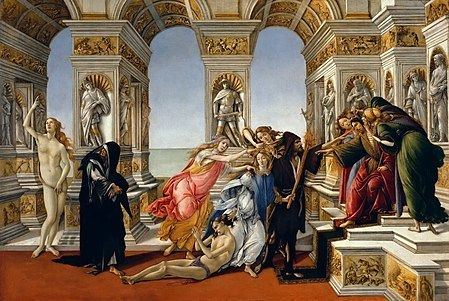Year 1494 Created 1494 | Medium Tempera on panel Period Early renaissance | |
 | ||
Dimensions 62 cm × 91 cm (24 in × 36 in) Similar Sandro Botticelli artwork, Early renaissance artwork | ||
The Calumny of Apelles is a tempera painting by Italian Renaissance painter Sandro Botticelli. Based on the description of a painting by Apelles, the work was completed in approximately 1494. It is on display in the Uffizi in Florence.
Contents
Theme
In The Calumny of Apelles, Botticelli drew on the description of a painting by Apelles, a Greek painter of the Hellenistic Period. Though Apelles' works have not survived, Lucian recorded details of one in his On Calumny:
On the right of it sits Midas with very large ears, extending his hand to Slander while she is still at some distance from him. Near him, on one side, stand two women—Ignorance and Suspicion. On the other side, Slander is coming up, a woman beautiful beyond measure, but full of malignant passion and excitement, evincing as she does fury and wrath by carrying in her left hand a blazing torch and with the other dragging by the hair a young man who stretches out his hands to heaven and calls the gods to witness his innocence. She is conducted by a pale ugly man who has piercing eye and looks as if he had wasted away in long illness; he represents envy. There are two women in attendance to Slander, one is Fraud and the other Conspiracy. They are followed by a woman dressed in deep mourning, with black clothes all in tatters—she is Repentance. At all events, she is turning back with tears in her eyes and casting a stealthy glance, full of shame, at Truth, who is slowly approaching.
Botticelli reproduced this quite closely, down to the donkey ears of the seated man, into which the women that flank him speak. A richly gowned Slander (or Calumny), with her hair being dressed by her attendants, is being led by her slender, robed companion. The man she is dragging, nearly nude and with his ankles crossed as if to be crucified, raises his hands in prayer. The woman behind him turns her head to regard the stately pale nude pointing to the heavens.
Without description of the setting, Botticelli has presented a throne room elaborately decorated with sculptures and reliefs of Classical heroes and battle scenes.
History
An apocryphal story is connected to the painting. Rudolph Altrocchi, in 1921, relates that Apelles had himself been slandered, accused by a rival of helping Theodotus of Aetolia to foster revolt in Tyre. (Altrocchi assures readers that the story cannot be true, as Apelles had been long dead before the revolt of which he is accused.) Ptolemy was on the verge of executing Apelles for the deed, so the story goes, when a friend revealed the truth and the slanderer himself was sold into slavery. Nevertheless, Apelles expressed his resentment for Ptolemy and the peril in which he found himself in his painting.
The story of Apelles' painting became popular in Renaissance Italy, and Botticelli was neither the first nor last Italian Renaissance artist to depict it. This work, completed in 1494, was the last secular painting he would produce. It may have been undertaken as a commission of the Florentian banker who oversaw the Papal Mint. It is often assumed that Botticelli had a specific slandered individual in mind, perhaps even himself, as an anonymous person had accused him of sodomy.
